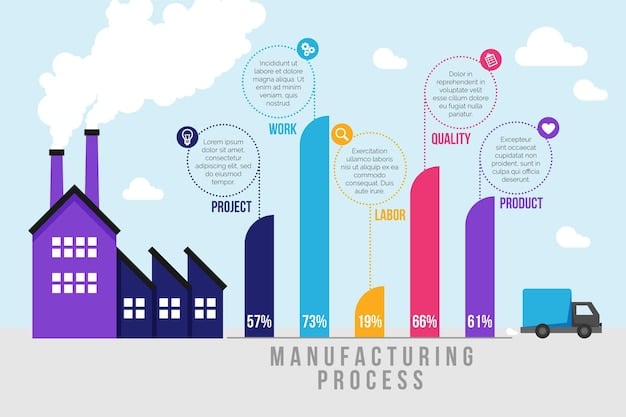BLS Employment Projections: What They Mean for Your Career

The latest Bureau of Labor Statistics (BLS) employment projections offer valuable insights into future job market trends, helping individuals make informed decisions about their career paths by identifying growing industries and occupations.
Navigating the ever-changing job market can feel like a daunting task. Luckily, the Bureau of Labor Statistics (BLS) provides employment projections that can serve as a roadmap for your career. Understanding what the latest Bureau of Labor Statistics (BLS) employment projections mean for your career is crucial for making informed decisions about your future.
Understanding the Bureau of Labor Statistics (BLS)
The Bureau of Labor Statistics (BLS) is a government agency within the U.S. Department of Labor. It is the principal Federal agency responsible for measuring labor market activity, working conditions, and price changes in the economy. The BLS releases employment projections periodically, offering insights into the future of the job market.
What are Employment Projections?
Employment projections are forecasts of the number of jobs expected to be available in different occupations and industries at a future date. These projections are based on a variety of factors, including historical trends, economic conditions, and anticipated technological advancements.
The BLS projections typically cover a 10-year period and provide detailed information about:
- Occupation employment: Expected growth or decline in specific occupations.
- Industry employment: Projected changes in employment across different industries.
- Education and training requirements: The level of education and training typically needed for various occupations.
- Earnings: Median annual wages for different occupations.
These projections are a valuable tool for anyone considering a career change, choosing a college major, or simply wanting to stay informed about the evolving job market.

Key Sectors Showing Growth According to BLS
The latest BLS employment projections highlight several sectors expected to experience significant growth over the next decade. Understanding these growth areas can help job seekers and career planners focus their efforts on promising opportunities.
Healthcare and Social Assistance
The healthcare and social assistance sector is projected to add the most new jobs. This growth is driven by an aging population and increasing demand for healthcare services. Occupations such as registered nurses, home health aides, and medical assistants are expected to be in high demand.
Professional and Business Services
The professional and business services sector is also expected to see substantial growth, driven by increasing demand for consulting, technology, and management services. Occupations such as management analysts, computer systems analysts, and software developers are projected to grow rapidly.
Industries with Declining Employment
While many sectors are expected to grow, some industries are projected to experience declines in employment. These include:
- Manufacturing: Due to automation and increased efficiency.
- Postal Service: Due to declining mail volume.
- Newspaper Publishing: Due to the shift to digital media.
Individuals in these industries may need to consider retraining or career transitions to find new opportunities.
Occupations with the Fastest Projected Growth
Beyond broad sectors, the BLS also identifies specific occupations expected to experience the fastest growth. These high-growth occupations often reflect emerging trends and technological advancements.

Wind Turbine Service Technicians
With the increasing focus on renewable energy, wind turbine service technicians are projected to be among the fastest-growing occupations. These technicians install, maintain, and repair wind turbines, ensuring they operate efficiently.
Data Scientists and Statisticians
The demand for data scientists and statisticians is soaring as organizations increasingly rely on data to make informed decisions. These professionals analyze large datasets, develop statistical models, and communicate insights to stakeholders.
Nurse Practitioners
As healthcare needs continue to grow, nurse practitioners are becoming increasingly important in providing primary and specialty care. They can diagnose and treat illnesses, prescribe medications, and provide preventive care services.
Education and Training Requirements for High-Growth Jobs
Many of the fastest-growing occupations require specialized education and training. Understanding these requirements can help individuals plan their education and career paths effectively.
Bachelor’s Degrees
Many professional and technical occupations, such as data scientists, software developers, and management analysts, typically require a bachelor’s degree. These programs provide a strong foundation in analytical and problem-solving skills.
Associate’s Degrees
Some healthcare occupations, such as registered nurses and respiratory therapists, often require an associate’s degree. These programs provide hands-on training and clinical experience.
Vocational Training
Certain skilled trades, such as wind turbine service technicians and solar photovoltaic installers, may require vocational training or apprenticeship programs. These programs provide specialized skills and knowledge in a specific field.
Implications for Career Changers and Job Seekers
The BLS employment projections have significant implications for career changers and job seekers. By understanding the trends and opportunities, individuals can make informed decisions about their career paths.
Identifying Growth Opportunities
Career changers can use the BLS projections to identify sectors and occupations with strong growth potential. This can help them focus their job search efforts on areas where there are more likely to be opportunities.
Retraining and Skill Development
Job seekers can use the BLS projections to identify skills and knowledge that are in high demand. This can help them prioritize retraining and skill development activities to improve their job prospects.
Leveraging Emerging Trends
The BLS projections can also help individuals anticipate emerging trends and technologies. This can allow them to position themselves for future opportunities by developing expertise in areas that are likely to be in high demand.
Using BLS Data for Long-Term Career Planning
The BLS employment projections are not just for immediate job searches; they are also valuable for long-term career planning. By considering the trends and opportunities identified by the BLS, individuals can make strategic decisions about their education, training, and career development.
Setting Realistic Goals
The BLS projections can help individuals set realistic career goals by providing insights into the expected growth and earnings potential of different occupations. This can help them make informed decisions about their career paths and avoid unrealistic expectations.
Adapting to Change
The job market is constantly evolving, and the BLS projections can help individuals adapt to change by identifying emerging trends and technologies. This can allow them to stay ahead of the curve and remain competitive in the job market.
Making Informed Decisions
Ultimately, the BLS employment projections are a valuable tool for making informed decisions about your career. By understanding the trends and opportunities, individuals can take control of their career paths and achieve their long-term goals.
| Key Point | Brief Description |
|---|---|
| 📈 Growth Sectors | Healthcare, professional, and business services are projected to grow. |
| 👩⚕️ High-Demand Occupations | Registered nurses, data scientists, and wind turbine technicians are in demand. |
| 📚 Education Matters | Bachelor’s and associate’s degrees enhance job opportunities. |
| 🔄 Adapting to Change | Staying informed and flexible opens new career paths. |
Frequently Asked Questions (FAQ)
▼
The Bureau of Labor Statistics is the principal federal agency responsible for measuring labor market activity, working conditions, and price changes in the U.S. economy. It’s a key source for employment data.
▼
The BLS typically releases employment projections every two years, providing a 10-year outlook on expected changes in the job market. Each release updates previous forecasts with new data.
▼
Healthcare and social assistance, as well as professional and business services, are projected to add the most new jobs. This reflects increasing demand for healthcare and specialized services.
▼
Wind turbine service technicians, data scientists, and nurse practitioners are among the fastest-growing occupations. These roles align with renewable energy and healthcare’s expanding needs.
▼
You can identify growth opportunities, assess required education and training, and anticipate emerging trends. This data aids realistic goal-setting and adapting to evolving job market demands.
Conclusion
Staying informed about the latest Bureau of Labor Statistics (BLS) employment projections is a powerful way to navigate your career path. By understanding which sectors are growing, which occupations are in demand, and what skills are needed, you can make strategic decisions that set you up for long-term success in the ever-evolving job market. Embrace these insights to shape a fulfilling and prosperous career.





